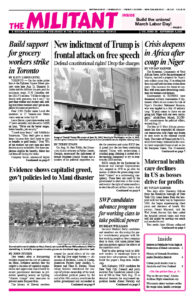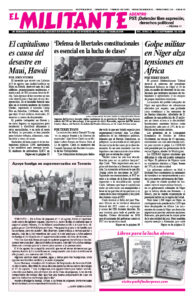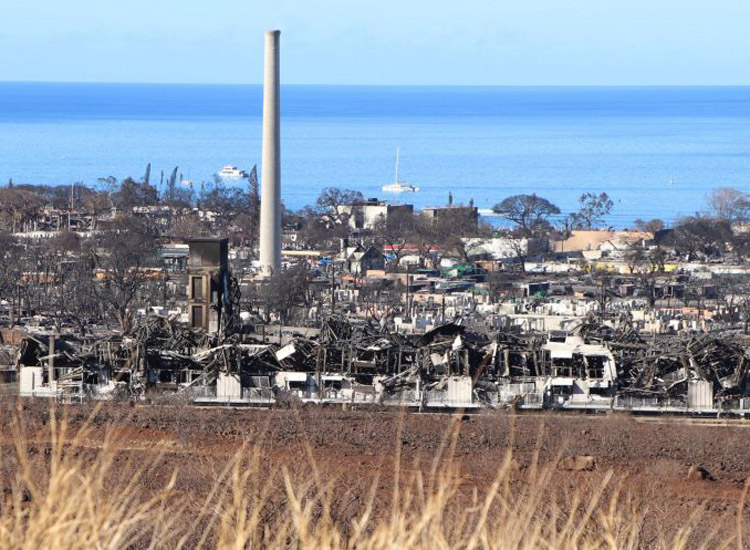Two weeks after a fast-moving wildfire wiped out the city of Lahaina on Maui, evidence mounts that the culprit is decades of capitalist exploitation and oppression exacerbated by recent government decisions to prioritize spending money on fighting “climate change” over measures to prevent more frequent fires.
The history of Hawaii revolves around the social effects of the rule of the Big Five sugar barons — Alexander & Baldwin, Castle & Cooke, American Factors (now Amfac), C. Brewer and Theo H. Davies. These ruling families introduced the concept of private ownership of the land, consolidated political power by the end of the 19th century, overthrew the native government and succeeded in turning the islands into a colony of Washington.
They took control over all the resources needed to assure handsome profits from sugar production. They gained control over thousands of acres on Maui and elsewhere. They diverted water supplies into growing and processing sugar cane, a notoriously water-consuming enterprise. They brought immigrant workers from throughout Asia and elsewhere to labor in their fields.
For decades the profits rolled in. Then, after the second imperialist World War, when competition from bosses with cheaper labor elsewhere ate at their profits, these now mightily wealthy families sold off their plantations. The last one shuttered in 2016. They used their accumulated fortunes, control over water and other resources, and political influence after Hawaii became a U.S. state in 1959 to diversify into vast holdings in the rapidly expanding tourist industry, retail chains, construction, land speculation and other investments.
Wild grasses and shrubs rapidly covered the land they left fallow. Native plants that had never faced competition fell before them. Today, fully one-quarter of state land in Hawaii is covered by invasive grasses. These grasses expanded to the edges and then into Lahaina, the former capital of the Hawaiian peoples.
One of the two biggest mills on Maui was the Amfac-owned Pioneer Mill, located in the outskirts of Lahaina and spreading into the foothills. It’s 14,000-acre cane fields employed more than 50,000 workers in the 1930s.
What caused the disaster?
When the deadly wildfire swept through Lahaina, it destroyed much of the city. As of Aug. 23, some 115 people are known dead and at least 800 still missing. Homes, stores, and all remnants of many people’s entire lives, including immigration papers, deeds and other government papers, were destroyed. Because schools were closed when the fire started, many children were left at home or with elderly relatives when their parents left for work. Some youth perished.
Local authorities, state officials and the Hawaiian Electric power company bosses were well aware of this history and of the growing likelihood of wildfire disasters.
The company had made proposals in 2022 to spend $190 million on some measures, including removing dead trees, replacing and upgrading power lines and other protective measures. But the bosses refused to begin work, saying nothing would be done until the state government approved a rate increase to make customers pay for the fixes. This is “a common occurrence when utilities seek to make large investments,” the Wall Street Journal said.
An even bigger problem is that utility bosses planned to spend more funds, not on protections against wildfires, but on increasing electricity generation and targeting “climate change-related stresses.” They were under pressure from Democratic-run state and federal government-mandated “green energy transition.”
Hawaiian Electric subsidized rooftop solar power and contracted for large-scale renewables to plug into its grid. And it spent less than $245,000 on wildfire projects on Maui between 2019 and 2022.
“Looking back with hindsight,” Doug McLeod, a consultant who served for years as the Maui county energy commissioner, told the Journal, “the utility was going out for bid with all these big renewable-energy projects.”
In fact, Hawaiian Electric officials privately told people that “the state’s parched grasslands were less of an urgent threat than California’s vast and dry timberlands.”
Many of the state’s Democratic Party-dominated elected officials try to blame “climate change” for the disaster. They can’t admit that it was a result of their indifference, inaction or the effects of decades of for-profit capitalist rule.
The liberal media repeats endlessly that the fire was so deadly because of winds whipped up by nearby Hurricane Dora. But there is no scientific basis for this claim. “Dora, even though it was a major hurricane, had a very small wind field, and it’s very far away from the state,” Honolulu-based meteorologist John Bravender told Reuters Aug. 21. The high winds that swept the fire across the grasslands and into Lahaina were caused by the way they accelerated coming down from the mountains.
And higher temperatures from “climate change” weren’t involved either. For days the temperatures had been in the 80s, average for this time of year.
“The largest factor at play with this fire,” climatologist Abby Frazer told Reuters, was the invasive grasses.
Thousands on Maui have lost their jobs, homes, and most of their possessions, and many have lost loved ones. They’re angry at the government for the lack of response or help. “We were all on our own,” 72-year-old Tina Bass told the New York Times.
It was only the selfless solidarity of fellow workers and aid from working people near and far that have got them through.


